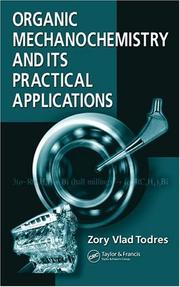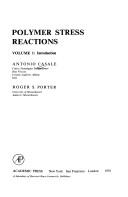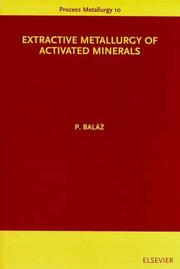| Listing 1 - 10 of 30 | << page >> |
Sort by
|
Book

ISBN: 2759823172 9782759823178 9782759822003 Year: 2021 Publisher: Les Ulis
Abstract | Keywords | Export | Availability | Bookmark
 Loading...
Loading...Choose an application
- Reference Manager
- EndNote
- RefWorks (Direct export to RefWorks)
This multidisciplinary book is the result of a collective work synthesizing presentations made by various specialists during the CNRS «BIODEMAT» school, which took place in October 2014 in La Rochelle (France). It is designed for readers of a range of scientific specialties (chemistry, biology, physics, etc.) and examines various industrial problems (e.g., water, sewerage and maintaining building materials). Metallic, cementitious, polymeric and composite materials age depending on their service and operational environments. In such cases, the presence of microorganisms can lead to biodeterioration. However, microorganisms can also help protect structures, provided their immense possibilities are mastered and put to good use. This book is divided into five themes related to biocolonization, material biodeterioration, and potential improvements to such materials resulting in better performance levels with respect to biodeterioration: • physical chemistry of surfaces; • biofilm implication in biodeterioration; • biocorrosion of metallic materials; • biodeterioration of non-metallic materials; • design and modification of materials. The affiliations of the authors of the various chapters illustrate the synergy between academic research and its transfer to industry. This demonstrates the essential interaction between the various actors in this complex field: analysing, understanding, and responding to the scientific issues related to biodeterioration.
Book
ISBN: 0128025255 0128021845 9780128025253 9780128021842 Year: 2016 Publisher: Amsterdam: Elsevier,
Abstract | Keywords | Export | Availability | Bookmark
 Loading...
Loading...Choose an application
- Reference Manager
- EndNote
- RefWorks (Direct export to RefWorks)
Mechanical chemistry. --- Organic compounds --- Synthesis. --- Chemistry, Organic --- Chemistry, Synthetic organic --- Organic synthesis (Chemistry) --- Synthetic organic chemistry --- Mechanically induced chemical reactions --- Mechanochemistry --- Stress induced chemical reactions --- Chemistry, Physical and theoretical --- Synthesis

ISBN: 0849340780 9780849340789 Year: 1977 Publisher: Cleveland CRC Press
Abstract | Keywords | Export | Availability | Bookmark
 Loading...
Loading...Choose an application
- Reference Manager
- EndNote
- RefWorks (Direct export to RefWorks)
Mechanical chemistry. --- Chemistry, Organic. --- 547.03 --- Organic chemistry --- Chemistry --- Mechanically induced chemical reactions --- Mechanochemistry --- Stress induced chemical reactions --- Chemistry, Physical and theoretical --- Physical organic chemistry --- Mechanical chemistry --- Chemistry, Organic
Periodical
ISSN: 23399686 Year: 1921 Publisher: [Barcelona (Sarría)] : La Asociación
Abstract | Keywords | Export | Availability | Bookmark
 Loading...
Loading...Choose an application
- Reference Manager
- EndNote
- RefWorks (Direct export to RefWorks)
Chemistry, Technical --- Chemistry --- Physical and Chemical Sciences --- analytical chemistry --- chemical composition --- chemoinformatics --- electrochemistry --- geochemistry --- hydrochemistry --- mechanochemistry --- organic chemistry --- photochemistry --- physical chemistry --- physical phases --- physicochemical properties --- processing chemistry --- reaction chemistry --- stereochemistry --- atmospheric chemistry --- chemists --- green chemistry --- laboratory techniques --- chemistry

ISBN: 0121628019 0323140890 1299442382 9780121628017 9780121628024 0121628027 Year: 1979 Publisher: New York (N.Y.): Academic press
Abstract | Keywords | Export | Availability | Bookmark
 Loading...
Loading...Choose an application
- Reference Manager
- EndNote
- RefWorks (Direct export to RefWorks)
Polymers --- Mechanical chemistry --- Polymères --- 678.01:539.43 --- Polymere --- Polymeride --- Polymers and polymerization --- Macromolecules --- Mechanically induced chemical reactions --- Mechanochemistry --- Stress induced chemical reactions --- Chemistry, Physical and theoretical --- Properties. Defects. Constitution. Serviceability. Sampling. Analysis. Testing-:-Resistance to repeated stresses --- 678.01:539.43 Properties. Defects. Constitution. Serviceability. Sampling. Analysis. Testing-:-Resistance to repeated stresses --- Polymères
Book
ISBN: 3039217798 303921778X Year: 2019 Publisher: MDPI - Multidisciplinary Digital Publishing Institute
Abstract | Keywords | Export | Availability | Bookmark
 Loading...
Loading...Choose an application
- Reference Manager
- EndNote
- RefWorks (Direct export to RefWorks)
Increasing attention is being paid to the development of effective technologies for the sequestration of CO2 and its storage. Hopefully, this will result in processes that can lead to its valorisation as a chemical, e.g., for the regeneration of fuels, but also for the production of intermediates. These are usually energy demands and rather slow processes, requiring energy input and catalysts. Some examples are the innovative strategies for the hydrogenation, photoconversion, or electroreduction of carbon dioxide. This book collects original research papers, reviews, and commentaries focused on the challenges related to the valorisation and conversion of CO2.
microwaves --- dimethyl carbonate --- n/a --- dynamic reaction conditions --- catalysis --- water sorption --- alkali promoter --- Titania --- high pressure photocatalysis --- diatomite --- photoreduction --- catalyst preparation --- dehydration --- CO2 reduction --- photocatalysis --- CO2 hydrogenation --- carbon dioxide --- mechanochemistry --- CO2 electro-reduction --- surface oxidation-reduction --- operando XAS --- metal-carbon-CNF composites --- carbon nanofibers --- ultrasound --- carbon-based electrodes --- water diffusion --- alkali oxide --- quick-EXAFS --- H2 dropout --- CO2 methanation --- plastic waste
Book
ISBN: 3030752240 3030752232 Year: 2021 Publisher: Cham, Switzerland : Springer,
Abstract | Keywords | Export | Availability | Bookmark
 Loading...
Loading...Choose an application
- Reference Manager
- EndNote
- RefWorks (Direct export to RefWorks)
Mechanical chemistry. --- Recycling (Waste, etc.) --- Conversion of waste products --- Recovery of natural resources --- Recovery of waste materials --- Resource recovery --- Waste recycling --- Waste reuse --- Conservation of natural resources --- Refuse and refuse disposal --- Energy conservation --- Salvage (Waste, etc.) --- Waste products --- Mechanically induced chemical reactions --- Mechanochemistry --- Stress induced chemical reactions --- Chemistry, Physical and theoretical

ISBN: 9780444502063 0444502068 0080531539 9780080531533 9786611048280 1281048283 Year: 2000 Publisher: New York ; Amsterdam : Elsevier,
Abstract | Keywords | Export | Availability | Bookmark
 Loading...
Loading...Choose an application
- Reference Manager
- EndNote
- RefWorks (Direct export to RefWorks)
Mechanical activation of solids is a part of mechanochemistry, the science with a sound theoretical foundation exhibiting a wide range of potential application. Mechanical activation itself is an innovative procedure where an improvement in technological processes can be attained via a combination of new surface area and defects formation in minerals. Mechanical activation is of exceptional importance in extractive metallurgy and mineral processing and this area forms the topic of this book and is the result of more than twenty years of research and graduate teaching in the field. In p
Ore-dressing. --- Mechanical chemistry. --- Size reduction of materials. --- Comminution --- Grinding (Size reduction) --- Particle size reduction --- Mills and mill-work --- Mechanically induced chemical reactions --- Mechanochemistry --- Stress induced chemical reactions --- Chemistry, Physical and theoretical --- Beneficiation of ores --- Dressing of ores --- Jigging --- Milling (Metallurgy) --- Mineral dressing --- Mineral processing --- Ore treatment --- Smelting
Periodical
ISSN: 03525139 18207421 Publisher: Beograd
Abstract | Keywords | Export | Availability | Bookmark
 Loading...
Loading...Choose an application
- Reference Manager
- EndNote
- RefWorks (Direct export to RefWorks)
Chemistry --- Chimie --- Periodicals --- Périodiques --- Engineering --- Life Sciences --- General and Others --- Chemical Engineering --- Biochemistry --- Périodiques --- DOAJ-E EJCHIMI EPUB-ALPHA-J EPUB-PER-FT --- chemistry --- materials science --- chemical technology --- engineering --- Chemistry. --- Physical sciences --- Periodicals. --- Physical and Chemical Sciences --- analytical chemistry --- chemical composition --- chemoinformatics --- electrochemistry --- geochemistry --- hydrochemistry --- mechanochemistry --- organic chemistry --- photochemistry --- physical chemistry --- physical phases --- physicochemical properties --- processing chemistry --- reaction chemistry --- stereochemistry --- atmospheric chemistry --- chemists --- green chemistry --- laboratory techniques
Book
ISBN: 1281853658 9786611853655 3540748555 3540748547 3642094260 Year: 2008 Publisher: Berlin : Springer,
Abstract | Keywords | Export | Availability | Bookmark
 Loading...
Loading...Choose an application
- Reference Manager
- EndNote
- RefWorks (Direct export to RefWorks)
Mechanochemistry as a branch of solid state chemistry enquires into processes which proceed in solids due to the application of mechanical energy. This provides a thorough, up to date overview of mechanochemistry of solids and minerals. Applications of mechanochemistry in nanoscience with special impact on nanogeoscience are described. Selected advanced identification methods, most frequently applied in nanoscience, are described as well as the advantage of mechanochemical approach in minerals engineering. Examples of industrial applications are given. Mechanochemical technology is being applied in many industrial fields: powder metallurgy (synthesis of nanometals, alloys and nanocompounds), building industry (activation of cements), chemical industry (solid waste treatment, catalyst synthesis, coal ashes utilization), minerals engineering (ore enrichment, enhancement of processes of extractive metallurgy), agriculture industry (solubility increase of fertilizers), and pharmaceutical industry (improvement of solubility and bioavailability of drugs). This reference serves as an introduction to newcomers to mechanochemistry, and encourages more experienced researchers to broaden their knowledge and discover novel applications in the field.
Mineralogical chemistry. --- Nanoscience. --- Mechanical chemistry. --- Mechanically induced chemical reactions --- Mechanochemistry --- Stress induced chemical reactions --- Chemistry, Physical and theoretical --- Nano science --- Nanoscale science --- Nanosciences --- Science --- Chemistry, Mineralogical --- Mineral chemistry --- Geochemistry --- Materials. --- Nanotechnology. --- Mineralogy. --- Geochemistry. --- Mechanics. --- Mechanics, Applied. --- Materials Science, general. --- Solid Mechanics. --- Geotechnical Engineering & Applied Earth Sciences. --- Applied mechanics --- Engineering, Mechanical --- Engineering mathematics --- Classical mechanics --- Newtonian mechanics --- Physics --- Dynamics --- Quantum theory --- Chemical composition of the earth --- Chemical geology --- Geological chemistry --- Geology, Chemical --- Chemistry --- Earth sciences --- Physical geology --- Crystallography --- Minerals --- Molecular technology --- Nanoscale technology --- High technology --- Engineering --- Engineering materials --- Industrial materials --- Engineering design --- Manufacturing processes --- Materials --- Materials science. --- Geotechnical engineering. --- Engineering, Geotechnical --- Geotechnics --- Geotechnology --- Engineering geology --- Material science --- Physical sciences
| Listing 1 - 10 of 30 | << page >> |
Sort by
|

 Search
Search Feedback
Feedback About UniCat
About UniCat  Help
Help News
News